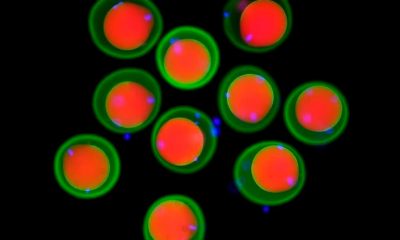Updated Jan. 21, 2024 at 6:30 p.m
BERLIN — The naked truth is hanging on every wall, clear to see in every picture. In drawings, etchings and prints, but also in three dimensional forms, made of bronze, marble or plaster. It is nothing new, really. Because of course, the early history of art is dominated by the male gaze.
Men were the creators and celebrated their own physical form — as muscular gods, dashing heroes, square-jawed emperors and, less often, delicate youths. But almost always naked.
✉️ You can receive our LGBTQ+ International roundup every week directly in your inbox. Subscribe here.
Women had to be goddesses, usually Venus, in order to be depicted in the nude. The person looking at them was usually a man, and they were made by the hands of men. Therefore their portrayal is filtered through the male gaze. And sometimes it seems that these women look more like muscular men with breasts and fairly narrow hips.
With the major fall exhibition “Michelangelo and Beyond” at Vienna’s Albertina Museum, outgoing director Klaus Albrecht Schröder has once again achieved a smash hit. It is clear from the exhibition’s neutral title that it was targeting a wide audience.
<!–
–>
An age-old story
The exhibition is based on Michelangelo’s drawings, most of which are taken from the collection of Peter Paul Rubens, who was a great admirer of Michelangelo’s work. The first few rooms offer a visual exploration of the stylistics of the male nude until the early 20th century. They draw on both famous and lesser-known works from the museum’s seemingly endless vault. It then moves on to the work of Klimt and Schiele — we are in Vienna, after all — and explores how these two leading figures in the world of modern art turned their unembarrassed gaze on women (or themselves).
As if everyone doesn’t sometimes want to sneak a peek at a naked body…
It almost seems like the exhibition’s curators felt bashful about the plethora of rippling muscles, unbridled physical strength, surging testosterone, coyly or defiantly presented penises, plump scrotums and taut buttocks on display, and chose to close the exhibition with reassuring female breasts. Because, of course, this gaze trained on the male form is also, unavoidably, one of desire. Often the desire of gay artists for their models.
Only that is never explicitly stated. Perhaps because the curators didn’t want to scare off certain visitors, instead choosing to guide them as neutrally as possible through this array of virile carnality? As if everyone doesn’t sometimes want to sneak a peek at a naked body — even if it is just to see how they measure up.
This is an old story. Today, the theme of sexuality is often pushed to one side, confined to specialist exhibitions. In 2019, as part of the project “The Second Glance”at Berlin’s Bode-Museum, curator María López-Fanjul y Díez del Corral developed “All Forms of Love”, a specially curated but also highly practical catalogue that allows visitors to explore its collections from the perspective of diverse sexual identities.
<!–
–>
Homosexual readings
At Schloss Wilhelmshöhe in Kassel, the exhibition “Old Masters with a Queer Twist” adopted a similar approach, exploring a possible homosexual interpretation of 40 works — many by Little Masters taken from the museum’s vault — from portrayals of Jupiter and Ganymede to Apollo and Hyacinth.
But it is impossible to find a major exhibition about an old master that explores these themes, aside from acknowledging the role of Saint Sebastian as a queer icon. In 2009, gay publicist Ivan Nagel published the book Painting and Drama — again with a frustratingly neutral title — in which he argued that the inner circle of Giotto, Masaccio and Leonardo could be read as homosexual. He portrayed the Florentine Renaissance as a kind of gay tea party, in which the main movers and shakers were interested in sensuality as much as the avantgarde. But his arguments were not taken up by mainstream exhibitions, which remained laughably prudish.
The Catholic institution Diocesan Museum Freising, which has been impressive since it emerged from a long period of renovation, is not shying away from addressing themes of sexuality. Its recent show “Damned Lust!” featured Leonardo da Vinci’s androgynous “Angel in the Flesh”, in which the figure’s penis has been roughly scratched out because it is erect.
Five hundred years after his death, da Vinci’s widely accepted homosexuality formed at least part of the narrative. And a humorous book by gay art historians Jack Shoulder and Mark Small, based on an Instagram account, called Museum Bums: A Cheeky Look at Butts in Art, celebrated the plethora of backsides, both male and female, to be found in museums, whether painted in oils, carved in stone or crafted from metal.
But when it comes to the mainstream, curators (many of whom are gay themselves) seem to be holding back. Although the reviews of the fantastic Donatello retrospective at the Gemäldegalerie in Berlin celebrated his nude bronze of the dangerously young David (who has long been a gay icon), the artist is not once described as gay in the entire exhibition – the possibility is not even mentioned. The idea of the Renaissance Man, freely looking on the naked body for the first time since antiquity, is not only a rational idea, but a breathless, pulsating and emotional one.
Men’s bath
The Leopold Museum in Vienna is holding a long-overdue retrospective of the work of Max Oppenheimer (1885-1954), the half-forgotten Expressionist painter who was once accused of plagiarism by Oskar Kokoschka. Alongside his impressive portraits of contemporary musicians, the exhibition features a lot of male flesh. For example, his painting of the flagellation of Christ, in which the emaciated protagonist offers his body up to the naked torturers, has the feel of an S&M orgy.
Then there is the lithograph of Jesus being taken down from the cross, where the heap of entangled bodies hints at the exhaustion felt after “la petite morte”. The theme of sexuality is only explicitly addressed in one wall text, which explains how the Jewish artist was further endangered by his “homosexual tendencies.”
Dürer was a trailblazer with his frank portrayal of his own naked body.
Art as a kind of visible speech, visibile parlare, a dialogue made up of gestures, expressions and gazes. For Ivan Nagel, that is how centuries-old paintings endure and carry their message to us today. This also includes the encoding of sexual preferences, in a more or less explicit way. Of course it was not an art historian, but the author Reinhard Bröker, who in his book Dürer and the Men explored the sexual appetites of Germany’s most beloved Old Master.
Albrecht Dürer’s work is full of clues about (homo)sexuality — impressively swollen codpieces, erect sabres, streaming faucets, the V-sign (which also has sexual connotations in the work of other painters) and typically homosexual ways of dressing. Dürer was also a trailblazer when it comes to self-portraits, with his frank portrayal of his own naked body.
Bröker bases his argument on Dürer’s work, rather than accounts from the artist himself. And although some may have reservations about his conclusion, he sees Dürer’s pictures as brimming over with homosexual desire: from the intriguing and sensual woodcut “The Men’s Bath House”, to his many depictions of soldiers, as well as dandyish self-portraits wearing erotic clothing, his work is provocative, confident and brave. An artist who naturally didn’t know the term “homosexual”, but who shows himself to be at least very fluid or bisexual.
<!–
–><!–
–>
We don’t know for certain
“He wanted to make himself visible as a gay artist, to those who could recognize the signs but not to everyone,” Bröker argues. Dürer the gay artist, it has been whispered in every major exhibition because, when collected together, his works tell a clear story.
Yet the world of art history has always played this down. Curators argue that we don’t know for certain, just as Michelangelo also wrote letters to female friends, such as Vittoria Colonna. Many of the Michelangelo drawings on display in Venice come from the collection of Tommaso de Cavalieri, who was not only a student and collector but also Michelangelo’s beloved. The Albertina makes no mention of this.
Visitors do not need art historians to help them recognize this. Just a relatively healthy libido.
One of Michelangelo’s most famous male nudes, “The Battle of Cascina,” a fresco commissioned for the Palazzo Vecchio in Florence, was never completed. The image has been lost, so we can only experience it through drawings made by others. There are some sketches of details by Michelangelo himself — some of which are in Vienna. The 2010 exhibition “Michelangelo’s Dream” at the Courtauld Institute in London explored the artist’s attraction to men, mainly through his depictions of mythological figures.
But in Vienna, the bulging muscles of Florentine warriors, the tenderly drawn skin of male nudes and the markedly virile preparatory sketches for the Sybil on the dome of the Sistine Chapel speak much more plainly. As do the men who appear in the paintings of many Masters over the subsequent four centuries (including Dürer and Raphael, of course).
Any visitor who is paying attention can decipher this for themselves. And it is not just an abstract question of the range of bodies depicted, the representation of movement, twisting bodies or the foreshortening of perspective. Visitors do not need art historians to help them recognize this. Just a relatively healthy libido. And that has always been a good reason to visit a museum.
<!–

Source link
Related
























